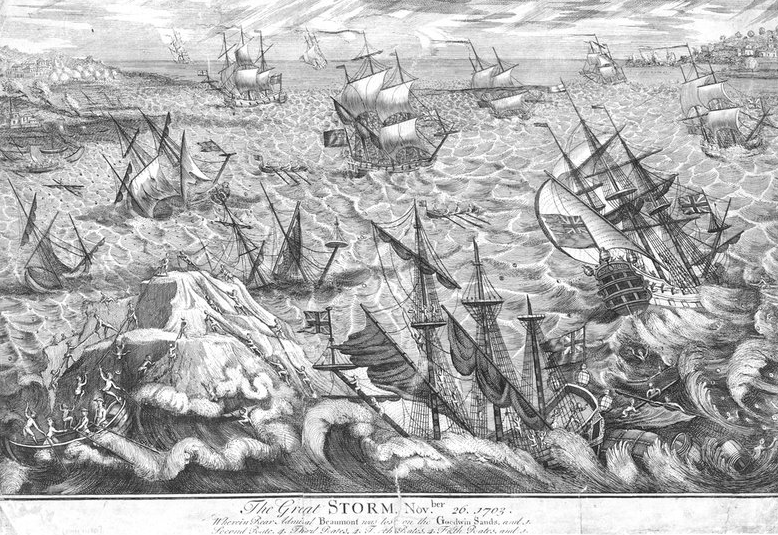The English East Coast town of Deal was well known to mariners in the 18th and 19th centuries. In this extract, Daniel Defoe describes the disastrous loss of ships in the great storm of November, 1703 following a summary of shipping on the Kentish shore.
Deal is famous for the road for shipping, so well known all over the trading world, by the name of the Downs, and where almost all ships which arrive from foreign parts for London, or go from London to foreign parts, and who pass the Channel, generally stop; the homeward-bound to dispatch letters, send their merchants and owners the good news of their arrival, and set their passengers on shoar, and the like; and the outward-bound to receive their last orders, letters, and farewells from owners, and friends, take in fresh provisions, &c.
Sometimes, and when the wind presents fair, ships do come in here, and pass thro’ at once, without coming to an anchor; for they are not oblig’d to stop, but for their own convenience: This place would be a very wild and dangerous road for ships, were it nor for the South Foreland, a head of land, forming the east point of the Kentish shoar; and is called, the South, as its situation respects the North Foreland; and which breaks the sea off, which would otherwise come rowling up from the west, this and a flat, or the bank of sands, which for three leagues together, and at about a league, or league and half distance run parallel with the shore, and are dry at low water, these two I say, break all the force of the sea, on the east and south, and south-west; so that the Downs is counted a very good road.
And yet on some particular winds, and especially, if they over-blow, the Downs proves a very wild road; ships are driven from their anchors, and often run on shoar, or are forced on the said sands, or into Sandwich-Bay, or Ramsgate-Peer, as above, in great distress; this is particularly when the wind blows hard at S.E. or at E. by N. or E.N.E. and some other points; and terrible havock has been made in the Downs at such times.
But the most unhappy account that can be given of any disaster in the Downs, is in the time of that terrible tempest, which we call by way of distinction, the Great Storm, being on 27th of November 1703, unhappy in particular; for that there chanced just at that time to be a great part of the royal navy under Sir Cloudesly Shovel, just come into the Downs, in their way to Chatham, to be laid up. Five of the biggest ships had the good hap to push thro’ the Downs the day before, finding the wind then blow very hard, and were come to an anchor at the Gunfleet; and had they had but one fair day more, they had been all safe at the Nore, or in the river Medway at Blackstakes.
There remained in the Downs about twelve sail when this terrible blast began, at which time England may be said to have received the greatest loss that ever happen’d to the royal navy at one time; either by weather, by enemies, or by any accident whatsoever; the short account of it, as they shewed it me in the town, I mean of what happened in the Downs, is as follows. The ‘Northumberland’, a third rate, carrying 70 guns, and 353 men; the ‘Restoration’, a second rate, carrying 76 guns, and 386 men; the ‘Sterling-Castle’, a second rate, carrying 80 guns, and 400 men, but had but 349 men on board; and the ‘Mary’, a third rate, of 64 guns, having 273 men on board; these were all lost, with all their men, high and low; except only one man out of the ‘Mary’, and 70 men out of the ‘Sterling-Castle’, who were taken up by boats from Deal. All this was besides the loss of merchants ships, which was exceeding great, not here only, but in almost all the ports in the south, and west of England; and also in Ireland.
Daniel Defoe, A Tour through the Whole Island of Great Britain, 1724 – 26
